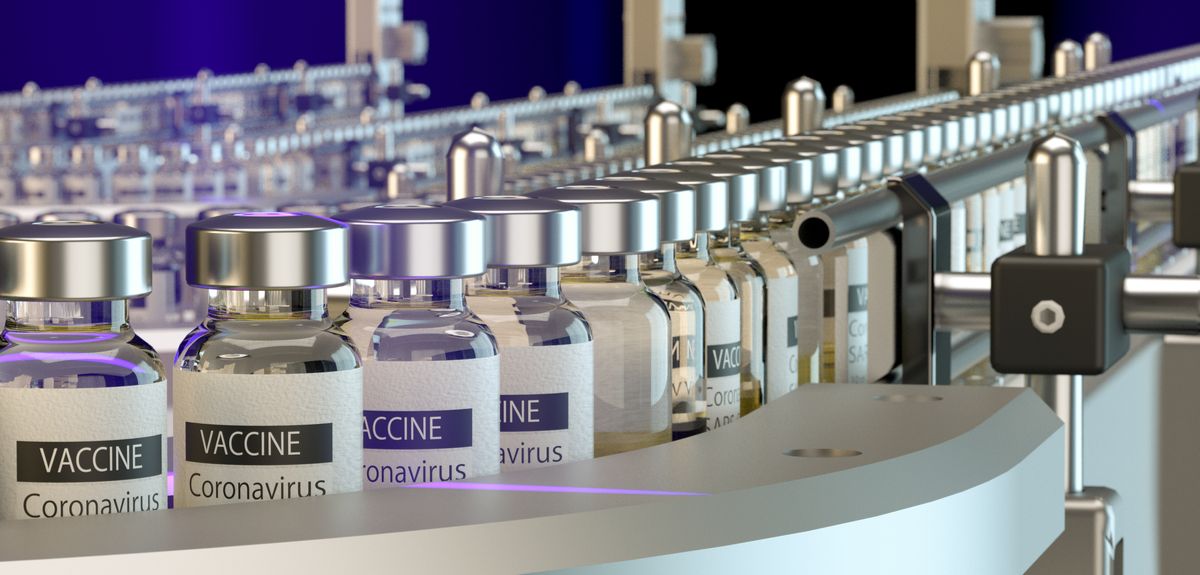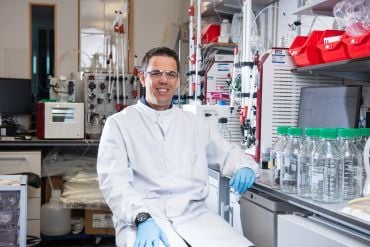
Making a billion doses of vaccine in 18 months: starting with two tablespoons
 Photo | Prof. Sandy Douglas in his lab
Photo | Prof. Sandy Douglas in his lab
By Dr Sandy Douglas
In April 2020, as the University was planning the first clinical trials for the COVID-19 vaccine, some began to wonder how to supply the vaccine to the world - if it worked. A rather worried colleague said to me, ‘But vaccine manufacturing is not really what we do, is it?’.
They were right in some ways: the University of Oxford is not a vaccine manufacturing company. A small group of University scientists had, however, been working on the problem for quite some time.
My team in the Jenner Institute had started research on manufacturing a few years earlier, to solve challenges around making an adenovirus-based rabies vaccine. The method we developed was designed to be very simple (so it could be done by many manufacturing facilities) and so it would work for other adenovirus-based vaccines (and might be useful for a new disease). Unfortunately, it had a major limitation: even if it were scaled-up massively, this method would not make enough vaccine to tackle a pandemic.
So, in early February 2020, it was a matter of concern that, although Oxford had the capacity to develop a COVID-19 vaccine, and clinical trials might take only a few months, manufacturing ‘at pandemic scale’ would take much longer. The technology simply was not in place.
In February 2020...although Oxford had the capacity to develop a COVID-19 vaccine...manufacturing ‘at pandemic scale’ would take much longer. The technology simply was not in place
A well-timed discovery provided a critical advance. At the start of the pandemic, a new team member, Dr Carina Joe, was the only researcher at the University working full-time on large-scale production of adenovirus vectored vaccines. In January 2020, she had found a way of creating up to 10 times more vaccine from a modified manufacturing process. She did this at a tiny scale: just 30 mL of cells (two tablespoons).
If the vaccine were going to be available quickly, this needed to be repeated on a scale at least 5,000 times greater, and before it was even known if the vaccine worked. Without ‘proof-of-concept’, that it could be made at such scale, it was unlikely any major funder or pharmaceutical company would support the vaccine programme.
We turned to the contacts book of Professor Catherine Green, Head of Clinical BioManufacturing Facility (where the first doses of the vaccine were being made for clinical trials), and started getting in touch with the handful of biotech companies in the UK and nearby who might be able to help.
The response was incredible. By late February, there was a plan for Carina’s ‘two tablespoons’ process to be tested on a large-scale ‘practice run’ at Pall Biotech’s lab in Portsmouth. Work which would normally have taken years was compressed into a few months and, if successful, would show that the vaccine could be created at ‘pandemic scale’.
A well-timed discovery provided a critical advance...a new team member, Dr Carina Joe...found a way of creating up to 10 times more vaccine from a modified manufacturing process....at a tiny scale: just 30 mL of cells (two tablespoons).
At that point, the vaccine team had not produced a single dose of clinical-grade COVID-19 vaccine. So it seemed preposterous to discuss, even in private with colleagues, if the process could produce one billion doses. Some early calculations looked encouraging, but no single manufacturing site would be able to deliver the scale needed and we were worried that governments might choose to vaccinate their populations first - meaning that low- and middle-income countries (LMICs) would be at the back of the queue.
It was clear multiple sites were needed; a model known as ‘distributed manufacturing’. And they needed to be in multiple countries, including LMICs. This approach had never been set up at this speed or scale for a brand-new vaccine, but by mid-March 2020, five manufacturers were ready to start ‘technology transfer’ work.
By late February, there was a plan for Carina’s ‘two tablespoons’ process to be tested on a large-scale ‘practice run’ ...Work which would normally have taken years was compressed into a few months
While three – Oxford Biomedica, Cobra Biologics, and Halix – would initially work on a plan to supply the UK, the others were one of the biggest LMIC biological manufacturing contractors, and the biggest LMIC vaccine manufacturer.
Soon, other companies came on board to supply equipment and materials. Jenner project manager, Dr Adam Ritchie, worked hard to ensure this group was shaped into a co-operative consortium: all sharing information, effort, and a vision of delivering a vaccine for the world as safely and quickly as possible.
On the 30 March 2020, the UK government’s newly-formed Vaccines Taskforce was in touch. Two weeks later, and before Phase I clinical trial had started, we were discussing a £65 million proposal to fund the consortium to supply tens of millions of vaccine doses to the UK. This was accepted quickly, so February’s pipe dream had become April’s reality.
In March 2020, the newly-formed Vaccines Taskforce was in touch. Two weeks later, we were discussing a £65 million proposal to fund the consortium to supply tens of millions of vaccine doses to the UK...February’s pipe dream had become April’s reality
It is well known that AstraZeneca committed to sell the product on a not-for-profit basis during the pandemic, and in perpetuity in low- and middle-income countries. It is less well known that AZ also started manufacturing, ahead of clinical trial results and including at sites in LMICs. This was at least as important as the price. An inexpensive vaccine is of no use if it is not available.
AZ has continued with both the UK-oriented manufacturing consortium and our LMIC partners, including the Serum Institute of India. Together, these have provided a large proportion of the billion doses made to date. And they have gone far beyond this, transferring our process to produce the vaccine to more than 25 partners across at least 15 countries, including additional sites in LMICs.
The effort to manufacture this vaccine has been extraordinary...It has not yet been fully appreciated how radically different...from the public perception of ‘big pharma’.
Big challenges remain, but the effort to manufacture this vaccine has been extraordinary in so many ways. It has not yet been fully appreciated how radically different it has been from the public perception of ‘big pharma’
Going ‘all out’ for maximum volume of supply from multiple sites has been a huge task, even for a company of AZ’s size, and I remain to this day delighted with the professionalism and zeal with which I see their team approaching this task.
Big challenges remain, but the effort to manufacture this vaccine has been extraordinary in so many ways. It has not yet been fully appreciated how radically different it has been from the public perception of ‘big pharma’.
Dr Sandy Douglas is a research group leader in Oxford’s Jenner Institute, who and has led the University’s contribution to the manufacturing scale-up the COVID-19 vaccine.
 What US intervention could mean for displaced Venezuelans
What US intervention could mean for displaced Venezuelans  10 years on: The Oxford learning centre making an impact
10 years on: The Oxford learning centre making an impact Oxford and The Brilliant Club: inspiring the next generation of scholars
Oxford and The Brilliant Club: inspiring the next generation of scholars New course launched for the next generation of creative translators
New course launched for the next generation of creative translators The art of translation – raising the profile of languages in schools
The art of translation – raising the profile of languages in schools  Tracking resistance: Mapping the spread of drug-resistant malaria
Tracking resistance: Mapping the spread of drug-resistant malaria